PHIL RUDIN
Contributor
I have used both systems and I see little difference between the two.
Phil Rudin
Phil Rudin
Welcome to ScubaBoard, the world's largest scuba diving community. Registration is not required to read the forums, but we encourage you to join. Joining has its benefits and enables you to participate in the discussions.
Benefits of registering include
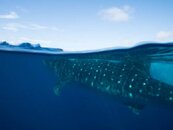
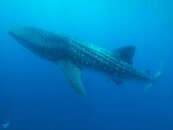
Even in this web-size image you can see that the head and tail of the shark is blurry in the 2nd photo.
* The Nauticam housing lock is poorly designed. The release button is right where you place your thumb when holding the housing. I almost flooded the housing when the lock came lose shortly after entering the water one time (I had the camera handed to me by the boat crew after entering the water). So be very careful about this!
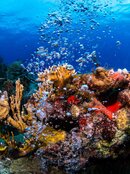
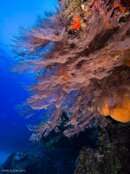
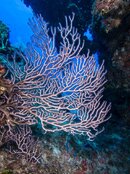
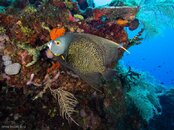
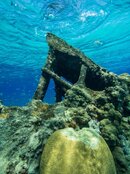
Regarding the color fringing seen in the corners when using the Nauticam 6" wide-angle port: The Panasonic 7-14mm has virtually no CA when used above-water with a Panasonic body. This is because the camera will auto-adjust for CA and embed that info in the RAW file. So even when viewed in Lightroom, images from this lens have no CA. In other words, the color fringing must come from something outside the lens - in this case it is refraction caused by the (misplaced) plexiglass dome port.
I just got back from Mexico where I used the NA-GX1 + 6" wide-angle port extensively. Thousands of frames, not one with sharp edges at 7mm. And the corners are a total blur. Of course it's always tricky to get sharp corners with a dome port underwater due to the curved field, but I remain convinced the poor dome placement is a key factor with this port.
Overall the setup performed OK for the whale sharks I went to photograph, mainly because I would frequently zoom to 10mm or even 14mm. But I would stay away from this lens & port combination for CFWA - I think the 8mm Fisheye would be a much better choice here. I tried a few CFWA shots just for testing purposes, and corners were a total blur at 7mm even when stopped down to f/18!
View attachment 133733View attachment 133734
First photo: 14mm f/14, 800 ISO
Second photo: 7mm f/9, 800 ISO
Even in this web-size image you can see that the head and tail of the shark is blurry in the 2nd photo.
Some good news about this port: It works real well for over/under photography. Since it's a section of a 9" dome, you get a nice thin water line, and it's easy to place the dome in the water. Keep in mind this is with the NA-GX1, with no viewfinder. That's actually a key drawback of the Panasonic GX1 - without a viewfinder it's pretty much impossible to frame over/under shots. So this was shot from the hip so to speak.
A couple more findings:
* The NA-GX1 + 6" wide-angle port is slightly positively buoyant when housing the GX1 + 7-14mm lens
* The lens will focus to about 2" in front of the port at 7mm, and about 4" in front of the port at 14mm. So lack of close focusing is not a problem.
* The Nauticam housing lock is poorly designed. The release button is right where you place your thumb when holding the housing. I almost flooded the housing when the lock came lose shortly after entering the water one time (I had the camera handed to me by the boat crew after entering the water). So be very careful about this!
Regards,
- Fabian
View attachment 133795View attachment 133796View attachment 133797View attachment 133798View attachment 133799
As some already know I have been using the Olympus 43 and M43 systems since they were introduced with the Olympus E-1. I also teach and assist with photo workshops for Reef Photo and NauticamUSA inculding the Nauticam Demo Days trip on the M/V Spree to the Dry Torgugas last weekend. We had about twenty-five diver in all diving four to five dives a day. Many of the divers had little to no experence with U/W cameras and others were quite advanced. We had Nauticam systems starting with two compacts all the way up to Nikon D-800 and Canon 5D Mk III being used by multiple divers with multiple card, battery, lens and dome changes. Most of these changes had to be made on the fly at the camera table. Vis was outstanding during many of the dives but we had lots of current and the camera systems needed to be hung from a down lines and then pulled up onto the dive platform rather than being handed up to the crew. So over 100 dives a day being made with the equipment by both workshop members and the crew of the Spree with several people using a different camera system on almost every dive. We had zero problems with any Nauticam housing leaking at the port or anywhere else. I would agree with Jone-Silver that the Nauticam port locking system is one of the very best in todays housing market and the only flood at the port I have heard about was when the owner didn't install the O-ring on the port before going into the water.
So I will post a few more images and let you be the judge of how well you all think the Panasonic 7-14 Zoom works with the Nauticam six inch dome port designed for the lens. The one 8mm fisheye shot shows how much closer you can get to the subject with a smaller dome port (100mm) without bumping the reef. Because I was using the Olympus E-M5 camera with the Panasonic lens I am able to use the 5-axis in-body IS with in lens and any CA is removed in lightroom rather than in the camera body as it is with the Panasonic M43 cameras. CA is seen more with the acrylic ports than with optical glass ports. I used a glass port in the 8mm fisheye shot and had IS turned off to avoid vegnetting of the dome in the corners of the image.
Phil Rudin
The 8mm fisheye shot (bubbles) was at F/6.3, the 7mm shots run from F/5.0 to F/8 all with the Olympus OMD E-M5 at ISO 200-400 at 1/250th.
Hi Fabian,
From all the images I've seen from friends, Phil, and on Flickr with any combination of the 7-14mm and either Nauticam or other ports, non have these bad a problem with blurry corners. Not sure what's going on, but from your images, it really seems like there's a breakdown occurring somewhere. As Long-John mentioned, maybe you can post the raw images so we can more easily evaluate?
My results are very similar to the pictures posted by Phil, above. You can see that the corners are somewhat soft even at web resolution. By comparison the 8mm fisheye performs much better.
Whether those results are acceptable is a decision we each have to make.
Regards,
- Fabian
I remain convinced the poor dome placement is a key factor with this port.
I'm just confused slightly as you've said many times above:
Does this mean you think that the poor dome placement is exacerbating the fact that at 7mm, the lens will have corner blurriness or that the dome placement is causing the 7mm's softness? Most mid-range wide angle lenses will be slightly blurry/soft when shot at 7mm so it seems you're saying that the dome is making this known limitation worse?
I accepted the fact that this Panny lens and most others in its price range will produce soft corners at 7-8mm in most situations on land before I bought it, so I'd expect no performance difference underwater. Otherwise, I'd get the 8mm fisheye as you mentioned.
Thanks,
Ryan

